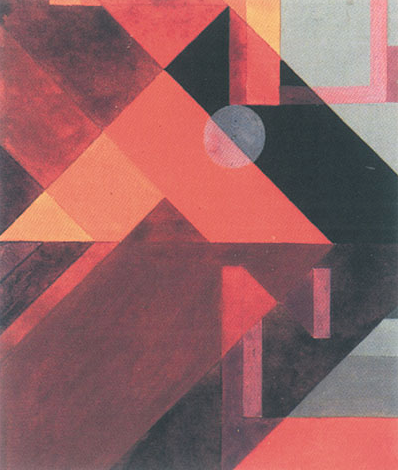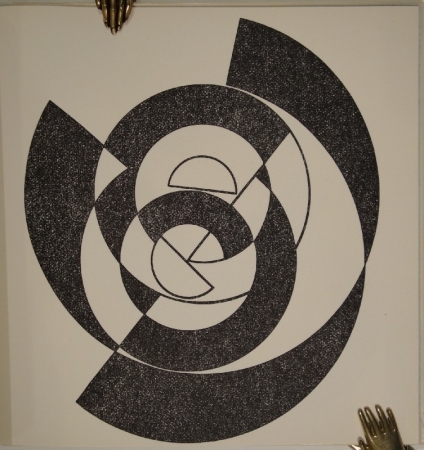

In the motley crowd of people that I have met throughout my
life, Sophie Taeuber was the most graceful and the most serene. She
lived like a figure in a prayer book, studious in her work and studious
in her dreaming. The reality of her dreams never foundered in the
reality of days. She was perfectly familiar with both realities. Whether
working in the garden, painting, or preparing for a trip, she would
devote herself to each task with a cheerful zeal and never rest
until she had performed it perfectly. Often I would catch her as she bent
over a table, attentively preparing her colors, carefully wiping the
brush on the edge of the saucer, diligently applying it to the canvas,
piously sketching the lines. Sometimes she would glance up and smile
with charming pride. Day and night were full of marvels for her. She
always looked forward to the coming of evening and dreams. A dream
would continue after she awoke, and at breakfast she would speak
about radiant worlds, sonorous forms, marvelous tales in which roses
and shadows, huge and blazing sun-umbrellas, happy souls and flights
all met in torrents of infinity. Walking with her was unspeakable bliss.
She greeted the world in tranquil joy. Every morning she would visit
her flowers like friends. She spoke to flowers and stars. She spoke
simply to both the tiniest and the largest creatures. She imitated the
chewing of crickets by wrinkling up her nose with amused concentration.
She took the trouble of carrying away in her closed hands the moths that
had strayed around a lamp. I don't know what mysterious intelligence
was exchanged between her and the butterflies. They would always come
hurrying to her; if she stretched out her arm, they would alight upon it;
they settled on her hat, her dress, and rested on her during long walks.
Calmly and precisely she would motion to them; and they would obediently
fly before or after her. She played with these lovely creatures and fled
from them, laughing. The carillon of her laughter was unforgettable.
I met Sophie Taeuber in Zurich in 1915. Even then she already knew
how to give direct and palpable shape to her inner reality. In those
days this kind of art was called "abstract art." Now it is known as
"concrete art," for nothing is more concrete than the psychic reality
that it expresses. Like music, this art is a tangible inner reality.
In the memoirs that the Parisian periodical XXe siècle published,
I wrote: "In 1915 Sophie Taeuber and I painted, embroidered, and did
collages; all these works were drawn from the simplest forms and were
probably the first examples of 'concrete art.' These works are realities,
pure and independent, with no meaning or cerebral intention. We rejected
all mimesis and description, giving free rein to the elementary and the spontaneous."
In 1915 Sophie Taeuber was already dividing the surface of a water
color into squares and rectangles which she juxtaposed horizontally and
perpendicularly. She constructed her painting like a work of masonry.
The colors are luminous, going from rawest yellow to deep red or blue.
In certain compositions she introduces on different levels squat and
massive figures anticipating those she subsequently fashioned in wood.
These figures could blosson into plants, dolls, vases, which in turn
became faces reflecting the dread of solitude and death. But the vigor
of youth, in its richness and brightness, disperses these shadows.
The water colors of the following period (circa 1920) are a
multicolored fabric of innumerable square and rectangular spots. Light
and shadow flourish, and no noisy clash or contrast disturbs the
harmony. Sophie Taeuber was overwhelmed by the feeling of decrepitude,
fragility, and complete inadequacy generated by earthly things. She
rejected the vanity of artistic fakery and saw perfection in humility.
Around 1930 she adopted a mode of composition in squares and
rectangles on a black or white unicolored background. Sometimes she
would introduce triangles or circles. She would often connect these
figures with straight lines and animate them against their white or
black depths with a rising or falling movement or an oscillation, or
else keep them motionless. Her palette knew hardly any colors but
blue, red, yellow and green. She conceived her works in larger
dimensions and did them in oils.
Around 1933 she eliminated straight lines, triangles, rectangles,
squares, and used only circles. The composition always proceeds from a
very strict basic arrangement that, after protracted work, always frees
itself in two or three dots from which the total power of the picture
radiates. They give it its tension and fill it with life and soul.
Several works in that period sometimes contain four or five different
compositions interwoven. These paintings are likewise composed on a
black or white monochrome background. She was painting the chessboard
of night. White, red, and green spheres serve as pawns for the night.
The night plays with the visible and the invisible. The invisible
beats the visible.
From 1936 to 1938 she did a series of wood reliefs. Certain of
these reliefs contain simple groupings of geometric forms,
appliquéd, cut out, or jutting. These reliefs are painted
white, black, red, and blue. The relief entitled Sea-shell
Armor-- vibrant white forms on a rectangular background-- attains
the perfection of beauty. It is with works of this sort that the word
beauty assumes its living sense. The last of these reliefs was
composed at the time when Sophie Taeuber was drawing a series of vases,
leaves, and metamorphosed sea shells to illustrate my book of poems
Sea Shells and Umbrellas (Muscheln und Schirme): this last
relief is so unusually perfect, its inner brightness is so great, that
I can compare its beauty to nothing less than that of a Greek amphora.
Most of the reliefs of that same period evolve from a circular
background. Earth and sky are intermingled like waves. Dark-green
leaves, deep-blue skies. These works have the solemnity of a wing, the
splendor of a glittering jewel.
In the years 1932, 1938, and 1939, Sophie Taeuber did four large
compositions in oil, in which she went back to the system of geometric
division of surface that she had used for her water colors in 1916.
She divides the surface into four, six or eight rectangular or square
planes of equal size, sometime uniting two or more of them in a single
flat level organized into smaller ones. Depths take shape and give the
whole a plane spatial reality. These surfaces no longer detach
themselves from the background as in the paintings done in 1933: now
they are two-dimensional spaces in which plane depths open up; surfaces
settle on other surfaces, lean on them, seem to advance toward the
onlooker, sink away, float along lines like flags on their poles.
These are two-dimensional spaces in which lines cut through surfaces,
limit the areas of light and dark, and share the image with one
another. Sophie Taeuber called those paintings Space Paintings.
These plane and spatial realities are created merely by the play of
colors and surfaces without the help of perspective or illusion of volume.
The image always remains flat, and never transgresses the law
dictated by the very nature of objects: the two-dimensionality of any picture.
Sophie Taeuber spent the last two years of her life with me in Grasse,
a town in Southern France. She really loved that area: it was her earthly
paradise. Whenever we went for a stroll, she was radiant with happiness.
She kept urging me on to more and more walks. Her eyes were always
fastened to the silvery-green olive groves, the meditative silhouettes of
the shepherds amid their flocks, the villages jutting up on the mountains,
the flittering, dazzling shield of the ocean. We lived between a well,
a graveyard, an echo, and a bell. A palm tree and some olive trees grew
in our garden. Whenever the palm fronds began to rustle, there was rain.
The olive trees were constantly animated by an almost imperceptible thrill:
each day was brighter and happier than the preceding one, and Sophie equaled
them all.
Her inner clarity struck everyone who met her. She blossomed like a
flower about to droop. The bright inwardness of her being brought
protection and comfort to anyone in suffering. From her purity she
drew the courage and confidence to endure the immense misfortune of
France. Her paintings were filled with glorious brightness. From the
depths of the most intense suffering, blossoming spheres shoot forth.
Depths and heights and rays rise and drop in a vast colored round.
Lost and impassioned, she drew lines, long curves, spirals, circles,
roads that twist through dream and reality. She painted her final
singing circles. In the turret where she had her room, she worked
ardently. Her fine approving profile lowered and rose before the
distant sea. The day before we left Grasse, she meticulously put her
tools in order and carefully stood her paintings against the wall to
let them dry. She was as content as one is after a lovely day.
She was always ready to receive darkness or light calmly. She was
serene, bright, truthful, precise, honest, incorruptible. She opened
life to skies of brightness.
